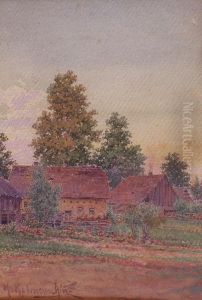Kostiatine Iakovitch Krijitskii Paintings
Konstantin Yakovlevich Kryzhitsky, born in 1858 in the Kharkov Governorate of the Russian Empire (now Ukraine), was a distinguished Russian-Ukrainian landscape painter. His artistic journey began with a military career, following in the footsteps of his family. However, his passion for art led him to pursue a different path. Kryzhitsky eventually resigned from the military to dedicate himself fully to painting, a decision that marked the beginning of his significant contribution to Russian and Ukrainian art of the late 19th and early 20th centuries.
Kryzhitsky's education in art took a formal turn when he entered the Imperial Academy of Arts in Saint Petersburg. There, he was profoundly influenced by the works of the Peredvizhniki (The Wanderers), a group of Russian realist artists who sought to engage directly with the social and political issues of their time through their art. Kryzhitsky was particularly drawn to landscape painting, finding in it a medium to express his deep appreciation for the natural beauty of the Russian and Ukrainian countryside.
Throughout his career, Kryzhitsky excelled in depicting the serene and idyllic landscapes of these regions, often highlighting the changing seasons and the harmonious relationship between human beings and nature. His works are characterized by their meticulous attention to detail, vibrant color palette, and the ability to evoke mood and atmosphere. Kryzhitsky's paintings were widely recognized for their artistic merit, earning him awards and recognition, including the prestigious title of Academician by the Imperial Academy of Arts.
Konstantin Kryzhitsky's contribution to art extends beyond his paintings. He was actively involved in the art community, participating in exhibitions and contributing to the development of emerging artists. His works were not only popular in Russia and Ukraine but also gained recognition abroad, contributing to the international appreciation of Russian and Ukrainian landscape painting.
Kryzhitsky's life and career were cut short when he died in 1911. Despite his relatively brief career, he left behind a legacy that continues to influence and inspire artists and art lovers. His paintings are preserved in numerous museums and private collections, serving as a testament to his skill and dedication to capturing the beauty of the natural world.
